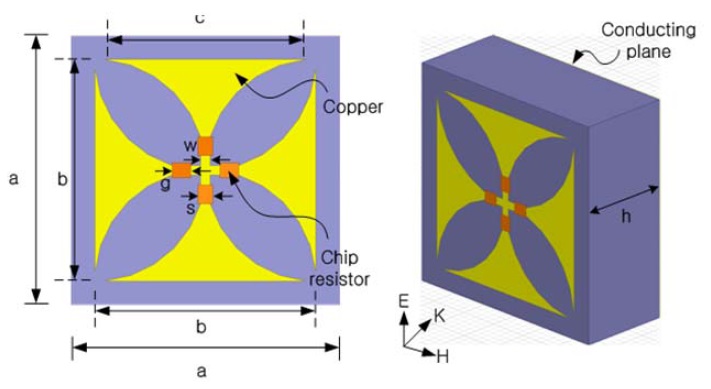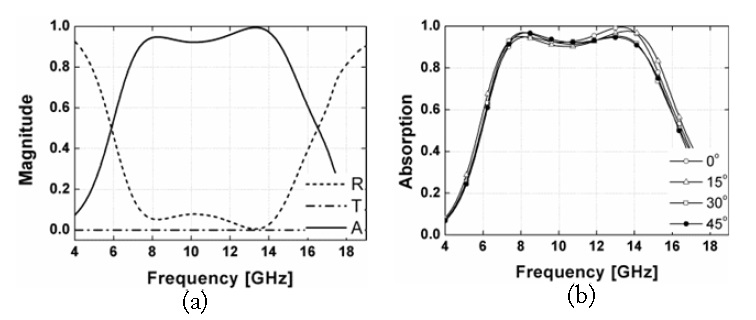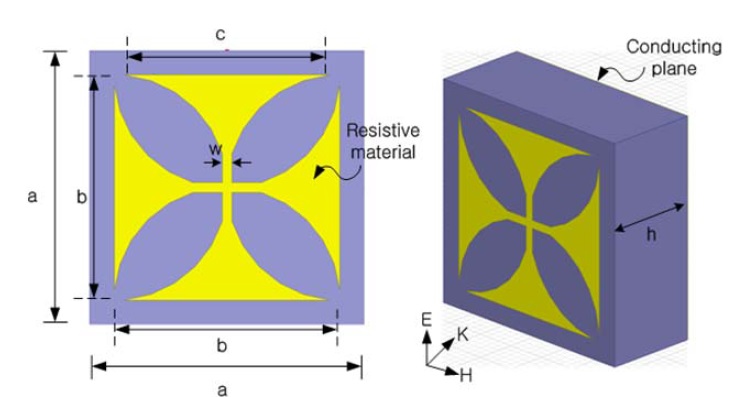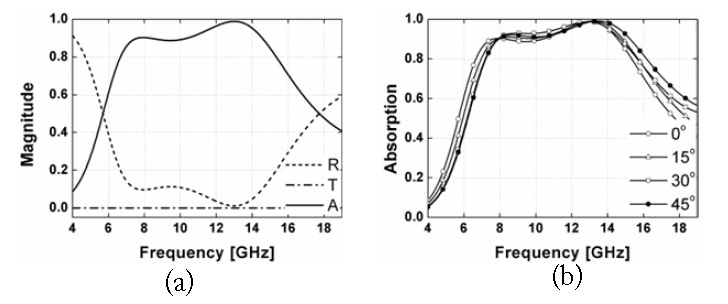



This letter presents two types of metamaterial-inspired absorbers adopting resistive trumpet structures at the X band. The unit cell of the first type is composed of a trumpet-shaped resonator loading a chip resistor, a metallic back plane, and a FR4 (εr = 4.4-j 0.02) substrate between them (single-layer). The absorption rate is 99.5% at 13.3 GHz. The full width at half maximum (FWHM) is 95 % at 11.2 GHz (from 5.9 to 16.5 GHz). The size of unit cell is 5.6×5.6×2.4 mm3. The second type has been optimized with a 7 Ω/square uniform resistive coating, removing the chip resistors but leading to results comparable to the first type. The proposed absorbers are almost insensitive to polarizations of incident waves due to symmetric geometry.
Electronic warfare has become an important issue in the current military environment. Suppression of unwanted scattering from conducting bodies is especially critical; consequently, much research is presently focused on low radar cross sections (RCS) using absorbing panels. Conventional ferrite tile absorbers are effective (typically about 20 dB absorption) in the frequency range below 1 GHz, but these are ineffective near the X-band.
Recent advancements in metamaterial research have opened the possibility for the development of a metamaterial absorber (MA) through microstructure engineered materials. The goal of a MA is to completely absorb the electromagnetic waves over a particular frequency band. The most common designs have been based on split-ring type resonators (SRRs), which have been widely studied for negative permeability and double negative metamaterial [1–3].
However, SRRs have an inherent preferred polarization direction and exhibit poor performance characteristics at oblique incidence angles. They also typically suffer from narrow bandwidth due to the highly dispersive nature of the structures. Many other designs have been suggested to improve the bandwidth of the absorbers, such as the Minkowski fractal frequency selective surface and two-layer structure [4,5]; however, these attempts further complicate the structure. A resistive pattern with a pre-defined surface resistance has also been studied for large-scale production and cost reduction [6].
In this letter, we present two types of metamaterial-inspired absorbers that adopt resistive trumpet structures. The proposed absorber exhibits nearly complete absorption over a wide frequency band (X-band) if well optimized, due to the inherent wideband nature of the trumpet structure that is used. It is also almost polarization-insensitive owing to the proposed symmetry.
II. DESIGN AND SIMULATION RESULTS OF PROPOSED ABSORBERS
Fig. 1 shows the geometry of the proposed absorber (case 1). The optimized geometrical dimensions of the proposed unit cell are:
Fig. 2 shows the EM-simulated results of the proposed absorber. We have used PEC boundaries on the top and bottom surfaces and used PMC boundaries on the side planes. For this kind of problem, the boundary condition used for a single unit is almost equivalent to using a Floquet port. As shown in Fig. 2(a), the metallic back plane ensures that the transmission is zero (
For this work,
Based on 90% absorption (
Fig. 2(b) shows the absorption (
In Table 1, we compare the absorption characteristics of the proposed absorber with those of others in terms of size, peak absorption, and 90% absorption bandwidth. Although a doublelayered absorber in [5] shows a substantial wideband characteristic, the absorption characteristics of this design with a single layer seem to be fairly good.
Fig. 3 shows the geometry of the proposed absorber with a resistive surface pattern having a uniform surface resistance per square (case 2). The optimized dimensions of the proposed unit cell are:
Fig. 4 shows the EM-simulated results of case 2. As shown in Fig. 4(a), the maximum absorption rate is 99% at 13 GHz. The FWHM is 102.8% at 11.7 GHz (5.7–17.7 GHz). The 90% absorption bandwidth is 64% at 11.6 GHz (7.9–15.3 GHz).
[Table 1.] Comparisons of absorption characteristics between the proposed absorber and others
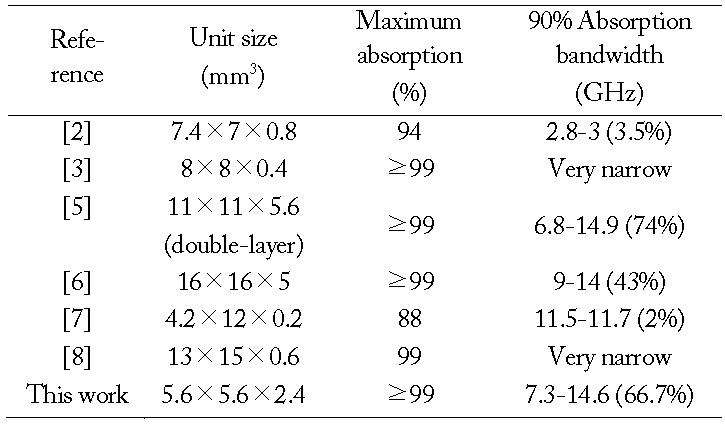
Comparisons of absorption characteristics between the proposed absorber and others
Fig. 4(b) shows that case 2 also maintains similar polarization insensitivity to that seen in case 1.
Two types of metamaterial-inspired wideband absorbers have been designed that adopt trumpet structures. The first one uses a copper surface pattern with chip resistors. The second one employs a uniform resistive surface pattern. Both types of absorbers are single-layered. The mechanism of wideband operations has been explained with simple and familiar circuit interpretation. Both designs show excellent wideband characteristics at the X-band, with high absorption. The proposed absorbers are also almost polarization-independent. In particular, the proposed absorber with uniform resistive pattern may facilitate mass production and may be adopted, for instance, to render combat aircraft invisible to X-band radars.
